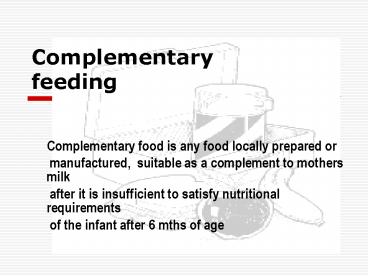Complementary feeding - PowerPoint PPT Presentation
1 / 15
Title:
Complementary feeding
Description:
Complementary feeding Complementary food is any food locally prepared or manufactured, suitable as a complement to mothers milk after it is insufficient to satisfy ... – PowerPoint PPT presentation
Number of Views:4426
Avg rating:3.0/5.0
Title: Complementary feeding
1
Complementary feeding
- Complementary food is any food locally prepared
or - manufactured, suitable as a complement to
mothers milk - after it is insufficient to satisfy nutritional
requirements - of the infant after 6 mths of age
2
Weaning vs complementary food
- Home made food to be emphasized
- Avoid use of word Weaning as it almost implies
that we advise to discontinue BF - Reinforce the need to continue BF in addition to
CF - Emphasize the need to start CF after completion
of 6 months
3
Why 6 months
- Energy gap
- at 6 mths 70 of cals and 80 proteins are
provided by breast milk - At 9 mths 50 cals and 60 proteins
- At 12-24 mths 30 cals and 40 proteins
- By 6 months voluntary control of sucking
swallowing is achieved and child doesnt push
solids out of the mouth - Pancreatic enzymes are fully matured.
- By 9 months child can use lips to clear a spoon
and use spoon to move food between teeth
4
When complementary foods are introduced too late
- Nutrition suffers
- Growth development slows downs or stops
- Risk of deficiencies iron , vit A ,Vit C
- Increase risk of diarrhoea, pneumonia due to
malnutrition - 60 of Under 5 deaths occur in malnourished
children
5
What to introduce ?
- Family food always
- First food
- - staple rice / wheat / maize/ ragi/
corn - - Starch potato
- - Fruits- banana /chickoo/sitaphal
- - Vegetables green leafy, peas,
beans - - Amylase rich flour- can be added to
staple
6
Balanced Diet
Energy Jaggery Butter Sugar Paneer Ghee Oil Chee
se
Staple Cereals Wheat, Rice Millets Ragi,
Bajra
Breastmilk
Proteins LegumesMatki Dals Moong, Masoor Nuts
Almonds Dairy items Butter, Paneer
Vitamins Minerals Fruits Vegetables
7
Foods to enrich staple
- Oil , butter , ghee
- Pulses use in ratio of 13
- Coconut, groundnut
- No sugary drinks soda , coffee , tea
- Use spoon katori but never BOTTLE
- Consistency of food should be like ghee
- which stays easily on spoon without running
off when tilted. - Later foods meat , poultry , eggs if consumed
by family - Mash food with hand and not mixer
- Avoid dal water,thin soups
8
Responsive feeding
- Practice responsive feeding- by giving help and
encouragement to the child by feeding slowly
and patiently and by experimenting with diff.
foods , taste, combinations textures. - Minimize distractions
- Use plenty of smiles, eye contact and encouraging
words so that feeding becomes a time for learning
and love - Dont force feed
9
Hygiene Sanitation
- Store food safely
- Use fresh foods if possible
- Use within 2 hrs if unrefrigerated
- Wash and clean hand and utensils before preparing
food and feeding - Avoid Feeding BOTTLES
- Kitchen garden
10
Frequency of feeding
- Energy needs from CF are
- - 200kcal /day at 6-8 months
- - 300kcal/day 9-11 months
- - 350kcal/day 12- 23 months
- 6 8 months feed 2-3 times a day
- 9- 24 months feed 3-4 times a day
- Nutritious snack can be given 1-2 times /day
- Continue breastfeeding till minimum 2 years
11
Consistency and Variety
- Begin with soft foods , but child learns to chew
by 8 months - By 8 months give them finger foods
- By 12 months they can eat all of family food from
family pot cut into small bits and softened if
needed. - By 12 months the child is able to eat ½ of what
an adult eats
12
Disadvantages of processed complementary foods
(tinned food, biscuits, bread etc)
- Main food may be starch sugar
- May be deficient in micronutrients
- Colour preservatives are added
- Bacterial contamination
- COST
13
Feeding the child who is ill
- Encourage the child to eat and drink with lot of
patience - Feed small amounts frequently
- Give foods that the child likes
- Give variety of nutrient rich foods
- Continue to breast feed
14
Feeding during recovery
- EXTRA Meal
- EXTRA amount of food
- EXTRA rich food
- EXTRA patience while feeding
- EXTRA breast feeds
- EXTRA love
- EXTRA duration for at least 2 weeks after illness
15
Thank You































